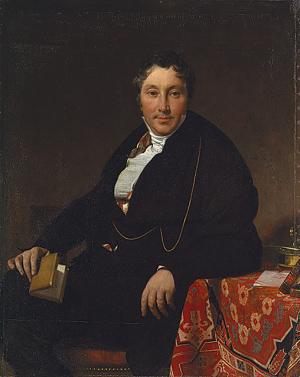
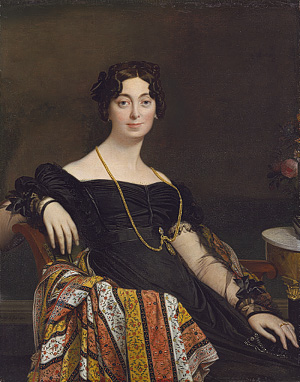 Madame
Jacques--Louis Leblanc (1788-1839), 1823
Madame
Jacques--Louis Leblanc (1788-1839), 1823Jacques-Louis Leblanc (1774–1846), 1823
Jean-Auguste-Dominique Ingres (French, 1780–1867)
(from the Metropolitan Museum of Art)
The 19th Century European Novel
Spring 2017
Prof. J. Moser
4232B; jmoser@brooklyn.cuny.edu
Office hours: M, 4-5:30 and by appt.
Course description:
This course includes works by Balzac, Flaubert, Dostoyevsky, Turgenev, Verga.
Discussion of the novels will be extended and enriched by readings and discussions
of the social, historical, cultural, philosophical, scientific and artistic
currents of the century. We will analyze not only the literary aspects of these
novels, but also the place of these works in the intellectual, social and historical
context of their times. In addition, each work will be considered through a
variety of critical lenses.
Course Requirements
There is a lot of reading to do for this course. You are expected to have read
all the material due before each class meeting.
Check the website for assignment updates.
There are 5 response papers. You may write these at any time during the semester,
before we discuss the reading or after, if you take a different approach from
those of the class discussions.
There will be one 5-page paper and an 8-10 page final research paper.
There will be one museum assignment that can be done either as a midterm project
or, in extended form, as the final project.
No late papers. If extraordinary circumstances prevent you from getting
your paper in on time, please email me.
Each student will lead discussion once during the semester---either to introduce
a secondary text or to start a close reading of a particular passage.
Each student will give a 10-15 minute presentation on his or her final paper
topic (last 3 class meetings)
Grades:
25% participation
25% response papers, explications, museum assignments
20% midterm paper
30% final paper (5% presentation; 25% paper)
Required Texts: (available at the college bookstore or online) You MUST
use the edition and translation listed below.
Balzac, Honoré de. Père Goriot. Trans. Burton Raffel. Norton
Critical Edition.
Flaubert, Gustave. Madame Bovary. Trans. Richard Howard. Norton Critical
Edition.
Dostoevsky. Crime and Punishment. Trans. Coulson. Norton Critical Edition
Turgenev, Ivan. Fathers and Sons. Trans. Richard Freeborn. Oxford
Verga,Giovanni. House Near the Medlar Tree. U Cal Press.
Paper Groups:
Group 1: paper due March 20:Ayala, Cooley, Eden, Green, Han, Mintzes, Neal,
Royas, Santos,Smith
Group 2: paper due April 7: Ciarrocchi, Demarest, Foreman, Hallmark, Inshan,
Naser, Petrovic, Romano, Schaedler, Taveras
Week 1: Monday, Jan. 30
Course requirements; syllabus; background to 19th-century novel; overview of
historical, social, cultural, artistic, technological and scientific trends;
close analysis of first pages of Pere Goriot (distributed in class); Balzac
as a "Dutch painter in prose."
Brief summary of 19th-century French history:
French Revolution (1789–1792)
French First Republic (1792–1804)
First French Empire under Napoleon I (1804–1814/1815)
Bourbon Restoration under Louis XVIII and Charles X (1814/1815–1830)
July Monarchy under Louis Philippe d'Orléans (1830–1848)
Second Republic (1848–1852)
Second Empire under Napoleon III (1852–1870)
Long Depression (1873-1890)
Belle Époque (1890-1914)
Look particularly at the portraits by Ingres. These are a good sources for information on fashion in the first half of the 19th century. In his essay 'The Painter of Modern Life', Baudelaire remarks how portraits "are clothed in the costume of their own period. They are perfectly harmonious because everything - from costume and coiffure down to gesture, glance and smile (for each age has a deportment, a glance and a smile of its own) - everything, I say, combines to form a completely viable whole."

 Madame
Jacques--Louis Leblanc (1788-1839), 1823
Madame
Jacques--Louis Leblanc (1788-1839), 1823
Jacques-Louis Leblanc (1774–1846), 1823
Jean-Auguste-Dominique Ingres (French, 1780–1867)
(from the Metropolitan Museum of Art)
Click the link below for a portrait of Louis-François Bertin (1766–1841),
a powerful newspaperman, owner of the Journal des débats, and
at the time Ingres portrayed him, a key supporter of King Louis-Philippe's constitutional
monarchy. When this portrait was exhibited at the Salon of 1833, crowds marveled
at its naturalism, though many critics found fault with the restrained palette.
The painting, Ingres's first popular success as a portraitist, has come to symbolize
the rise of the unapologetically self-satisfied bourgeoisie.
http://www.louvre.fr/en/oeuvre-notices/louis-francois-bertin
Link to the Metropolitan Museum of Art's page on realism: http://www.metmuseum.org/toah/hd/rlsm/hd_rlsm.htm
and 19th-century fashion: http://www.metmuseum.org/toah/hd/19sil/hd_19sil.htm
and 19th-century entertainment (from Brown University site) http://www.brown.edu/Facilities/University_Library/exhibits/paris/dailylife.html#entertainment
Read these poems from Charles Baudelaire's Fleurs du mal (1857):
Le vin des chiffoniniers (wine of the rag-pickers) http://fleursdumal.org/poem/193
A une passange: http://fleursdumal.org/poem/224
Reve parisien: http://fleursdumal.org/poem/228
Honore de Balzac, Le Pere Goriot (1834)
"The 19th century, as we know it, is largely an invention of Balzac's."
(Oscar Wilde)
""Where another writer makes an allusion, Balzac gives you a Dutch picture." (Henry James)
Week 2: Monday, Feb. 6
Pere Goriot, p. 5-126.
Henry James, "The Lesson of Balzac," p. 245-258.
Auerbach, p.279-289. Explain p. 284: "to him [Balzac] every milieu becomes
a moral and physical atmosphere which impregnates the landscape, the dwelling,
furniture, implements, clothing......its several milieux."
Discussion leaders:
Paris before the boulevards: (photos by Charles Marville)
Rue Chartière (impasse Chartière) de la rue de Reims,
Rue de la Montagne-Sainte-Geneviève.
Rue Arras
1865-69. Art Institute of Chicago
Paris after Haussmann: See http://www.arthistoryarchive.com/arthistory/architecture/Haussmanns-Architectural-Paris.html
and
http://www.mtholyoke.edu/courses/rschwart/hist255-s01/mapping-paris/Haussmann.html
for information about Haussmann
See http://www.artic.edu/aic/collections/exhibitions/Impressionism/Caillebotte
for description of Caillebotte's Paris Rainy Day below

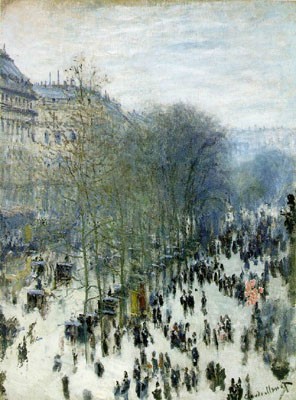 Monet, Boulevard
des capucines, Nelson-Atkins Museum
Monet, Boulevard
des capucines, Nelson-Atkins Museum
Week 3: Wednesday, Feb. 15 (conversion day)
Pere Goriot, p. 127-217
Brooks, "Representation and Signification," p. 314-328.
Barberis, "The Discovery of Solitude,", p. 304-314.
Mozet,"Description and Deciphering," p. 338-353.
Think about all the father-son relationships in the novel.
Be prepared to discuss the following topics: how things define people; Eugene's
rise in society; paternity; history as seen in the novel; city vs. country;
zoological comparisons; or any topic that might interest you---something you
particularly liked or something you had trouble understandin
Discussion leaders: Steven N.; Jerrett
Gustave Flaubert, Madame Bovary
Week 4: Monday, Feb 27:
Read Madame Bovary, p. 5-125
read Flaubert's letters to his lover, p. 300-310.
Baudelaire, p. 403-410
Culler, "The Uses of Uncertainty," 479-492
Barthes, The Reality Effect, 449-455
Be sure to look for examples of irony, horse and cow imagery.
Discussion leaders: Joe; Zaheeda
http://www.metmuseum.org/toah/works-of-art/19.77.2
http://www.metmuseum.org/toah/works-of-art/19.77.1
http://www.metmuseum.org/toah/works-of-art/1975.1.186
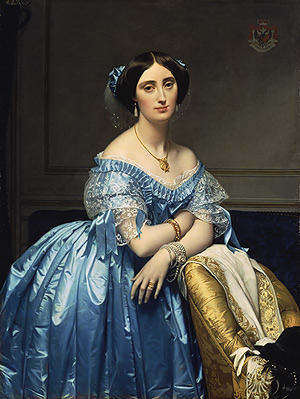
Princesse de Broglie, 1851.
Jean-Auguste-Dominique Ingres (French, 1780–1867)
(from the Metropolitan Museum of Art)
Week 5: Monday, March 6:
Madame Bovary (through p. 234)
Reread the scene at the ball.
Schor, Restricted Thematics, 499-512
Heath, "Provincial Manners," 461-470
Pay careful attention to the following images throughout the novel: water (and
anything liquid); windows; landscapes (particularly liquid allusions); circular
motions; notice the tense, and how it affects the mood; look for contrasts
(like the cow/horse allusions), especially in the scene of the agricultural
fair.
Find examples of free indirect discourse in Part 1 chapter 7
Be prepared to explain : "The human tongue is like a cracked cauldron on
which we beat out tunes to set a bear dancing when we would make the stars weep
with our melodies." (154)
Also, look carefully at the description of the ride Emma and Leon take in the
cab in Rouen (193-94)
Discussion leaders: Elizabeth, Ned, Priya
Paper 1, Group 1: Due Monday, Mar. 20 (by e-mail) :
Choose ONE of the following topics. All written work should be typed, 12 pt
font, double-spaced, standard margins.
1. Look at the dinner scenes. How do they affect the narrative? What purpose
do they serve both structurally and thematically?
2. Look at the painting by DeHooch (LINK). In what ways can it be said that
Balzac's work resembles a Dutch painting?
3.. The growth of consumerism and the shaping of the narrative in either Pere
Goriot of Madame Bovary.
4. Think about the theme of adultery. How is adultery in the 19th-century French
novel different from previous treatments of this topic? Look at the excerpts
(handed out in class) on adultery from the Jewish and Christian Bibles.
5. Is Emma a tragic hero? Why or why not?
6. Compare Madame Bovary to the other French realist novel we read, Pere
Goriot. What similarities do you find? what differences?
7 . Letter writing and literacy---how does Emma's correspondence shape the narrative?
Look at the painting "The Horse Fair" by Rosa Bonheur:
From the Metropolitan Museum of Art
Gustave Courbet's Burial at Ornans: http://www.musee-orsay.fr/en/collections/works-in-focus/search.html?no_cache=1&zoom=1&tx_damzoom_pi1[showUid]=2395
Courbet: : http//www.metmuseum.org/toah/hd/gust/hd_gust.htm
Jean-Francois Millet (from the Louvre website): http://cartelen.louvre.fr/cartelen/visite?srv=rs_display_res&critere=Jean-Francois+Millet&operator=AND&photoOnly=true&nbToDisplay=20&langue=fr
Week 6: Monday, March 13
Finish Madame Bovary
Matlock, "Censoring the Realist Gaze," 512-524
Llosa, "The First Modern Novel," 416-423
Tanner, Adultery in the Novel (link)
Final discussion of Madame Bovary. Find a passage, a sentence, an
image, an idea you want to discuss in class.
Look for recurring motifs: circular images; water (in many forms); masculinity;
blindness.
Be prepared to discuss the following characters: Binet, Homais, Lheureux, Guillaumin,
Bournisien, LaRiviere, Leon, Rodolphe, Mme Homais.
Are there any sympathetic characters in this novel?
Adultery:
Look at Rembrandt's Woman Taken in Adultery: http://www.nationalgallery.org.uk/paintings/rembrandt-the-woman-taken-in-adultery
and
Blake's The Woman Taken in Adultery (John VIII, 8–9) 1805 http://www.mfa.org/collections/object/the-woman-taken-in-adultery-john-viii-8-9-5040
Discussion leaders: Esther
Dostoevsky, CRIME AND PUNISHMENT
Week 7: Monday, March 20:
Parts I and II, Crime and Punishment, Norton Critical Edition
As you read, look for parallels with Pere Goriot. Dostoevsky read Balzac,
and even translated one of his novels into Russian.
Discussion leaders: Jessica; Sonja
Russian names and their English meanings:
Raskolnikov, Luzhin, Svidrigaïlov, Zametov, Marmeladov and Razhumikin have
some symbolic meanings in their last names. For every Russian reader it is the
obvious fact; however, in translation the meaning of names becomes lost.
Raskol’nik – schismatic
Luzha – puddle
Razum – reason, intelligence
Zametit’ – to notice
Marmelad – sort of sweet candy
Svidrigaïlov – name from medieval Russian history, Lithuanian prince
Map of Raskolnikov's journey to the pawnbroker's:
http://www.faculty.virginia.edu/dostoevsky/rutr/c-and-p.html
Biographical information (from Middlebury College website):
http://community.middlebury.edu/~beyer/courses/previous/ru351/bio.shtml
Inscription on Dostoevsky's tomb:
Verily, verily, I say unto you, Except a corn of wheat fall into the ground
and die, it abideth alone: but if it die, it bringeth forth much fruit.(from
John [12:24] )
Study Guide and Summary of Crime and Punishment from Middlebury College:
http://community.middlebury.edu/~beyer/courses/previous/ru351/novels/cp/CPstudy.shtml
Week 8: Monday, March 27:
Parts III and IV of Crime and Punishment
Pay careful attention to the discussion about Raskolnikov's article. What is
he proposing? When did it appear? How does he learn of its publication?
Read "Traditional Symbolism," p. 526-543.
Discussion leadesr: Bachi, Catherine
Week 9: Monday, April 3
Parts V and VI of Crime and Punishment
Discussion leaders: Scott, Steven S
Think about how Crime and Punishment fits, or adds to, the descriptions
of realism in the novels that we've read so far this semester
Paper 1 Group 2(due by midnight April 7by email)
1. Choose one symbol mentioned in the article "Traditional Symbolism"
and find and analyze an example of its use in Crime and Punishment.
For example, you might choose "air" and discuss Dostoevsky's description
of the air in St. Petersburg, or the air in Raskolnikov's room, or at the police
station.
2. How does St. Petersburg function as a character in the novel?
3. Look for parallels between the description of Svidrigaylov's final hours
and Raskolnikov's hours before he commits murder.
4. Analyze Svridigaylov's dream
5. Analyze the parallels between the murder scene and Raskolnikov's confession
scene in Sonia's room.
Spring Break: April 10-18
Turgenev, FATHERS AND SONS
Week 10: Thursday , April 20 (conversion day)
Read Chapters 1-19 of Turgenev's Fathers and Sons
I. Structure: Three estates and three transitions
Carriage ride
1. Mar´ino (Kirsanov brothers, Fenechka): a medium-sized estate (200 serfs)
Town of *** (Sitnikov, Kukshina)
2. Nikol´skoe (Anna and Katia Odintsova): a large estate
Carriage ride
3. "Small manor house" (Bazarov's parents): a poor estate (15-25 serfs)
Several journeys by the main characters back and forth among these estates
II. Names
" Arkadii: <Arcas, son of Zeus and King of Arcadia (which was named
after him), a sparsely populated, mountainous region in Central Greece adopted
by the poets as a symbol of the quiet, rustic life
" Bazarov: < Russ. bazar = bazaar; also, the noise and commotion attached
to it. Also < Russ. bazarit´/razbazarit´ = to waste one's time,
talent and energy on fruitless pursuits
" Kirsanov: < ? Russ. kirasir < Fr. cuirassier = a prestigious category
of officer in the Napoleonic period (reminiscent of Arkadii's grandfather, the
old general)
" Odintsova: < Russ. odin = one, alone, solitary, lonel
Kukshina: < Russ. kuksha = colloquial term for certain birds of the crow
family
" Sitnikov: < Russ. sitnik = a loaf of bread made from sifted flour
Discussion leaders: Tristan, Mohammed
Week 11: Monday, April 24
Finish Fathers and Sons
Consider the following questions:
1. Analyze the Bazarov/Odintsoya relationship, observing the similarities and
differences in their characters and the various stages in Bazarov's path to
self-realization.
What kind of person is Anna Odintsova? In what ways could Bazarov be viewed
as superior in comparison with Anna and the other characters? (Notice that the
name "Odintsova derives from odin, which means "one or "alone
.)
2. In chapter 13 Bazarov and Arkady meet two nihilists, Mrs. Kukshin and Sitnikov.
What is the purpose of this satirical characterization? What is the basic difference
between Bazarov and the two "emancipated" comrades?
Discussion leader: Junelle, Jaclyn, Yesenia
 Russian peasant hats,
19th century http://www.costumes.org/HISTORY/100pages/BOOKS/racinet/racinet1.htm
Russian peasant hats,
19th century http://www.costumes.org/HISTORY/100pages/BOOKS/racinet/racinet1.htm
Russian sarafan
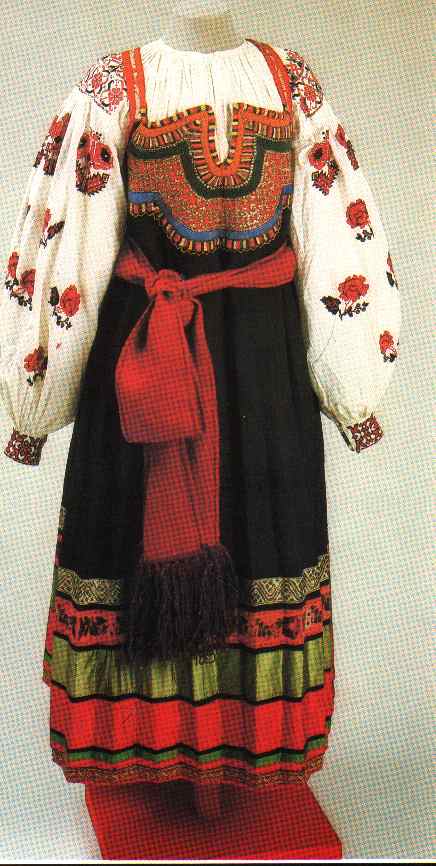
The Russian women's costume was based on the "sarafan" (a kind of
sleeveless dress). The "sarafan" ensemble became widespread in Russia
at the turn of the 18th century and comprised a shirt, "sarafan",
belt, and apron. This costume was especially typical of the northern and central
regions penetrating with time into the other parts of Russia where it ousted
the local traditional dress. In the 18th century it was already associated with
the Russian national costume. The "sarafan" was a daily attribute
of peasant womenfolk and urban women belonging to the merchant, petty-bourgeois
and other sections of the population.
The more archaic form of dress was based on the "poneva" skirt.
The earliest samples of national folk dress include festive costumes with "sarafans" of printed silken fabrics manufactured in Russia in the late 18th c. Their characteristic feature are oblique gores inserted between the sides of two straight widths in the front and one central width in the back. The "sarafan" had a long row of buttons in front and was suspended on wide straps. This type became known as the oblique-gore "sarafan". Another type was a simple affair of straight widths of cloth gathered in the front under a binding, having no buttons and also suspended on straps. It was known as the straight-cut or round "sarafan". The oblique-gore and straight-cut "sarafans" were genetically linked with ancient-Russian garments such as the "telogreya" (padded jacket) and "nakladnaya shubka" (outer coat). These diverse "sarafan" cuts could be observed in the 19th and early 20th cc. in different provinces of Russia.
"Sarafans" of silken fabrics printed with lavish flower bouquets and garlands were ornamented with golden gallons and metallic lace; silver or gilt buttons formed a decorative pattern along the seams. Such "sarafans" were worn with white shirts ("sleeves") of lawn or muslin heavily embroidered in chain-stitch with white thread, or with silken shirts of "sarafan" fabrics with flower prints. These festive "sarafans" and shirts were dearly valued and worn with care on holidays and handed down.
"Sarafans" were girdled at the waist with narrow belts having long
loose ends. In different localities this attire was supplemented with a short
"sarafan''-like garment - "epanechka", also made of silken manufactured
fabric and decorated with golden galloon. On cold days a long-sleeved jacket
-"dushegreya''-gathered on the back into tubular folds was worn. Its cut
differed from the traditional style and was close to that of civil-type clothes.
The festive "dushegre-ya" was made of silken fabric or velvet and
embroidered with golden thread. In Russia's northern provinces the silk "sarafan"
was worn with a head-dress decorated with needlework, pearls, golden and silver
threads and mother-of-pearl plaques. These materials were also used for pectoral
ornaments. from http://www.bashedu.ru/konkurs/kirsanova/English/club/russian.htm
For more pictures of peasant dress, soldier uniforms, St Petersburg, click
here:
http://faculty.virginia.edu/herman/tolstoy/russianvocabulary.htm
Week 12: Monday, May 1: Verga, The House by the Medlar Tree:
Discussion leader: Avery
Monday, May 1: FINAL PAPER PROPOSALS DUE BY THIS DATE (by e-mail). YOU MAY,
OF COURSE, SUBMIT THE PROPOSAL BEFORE THIS DATE.
In all cases, you must submit a one-page proposal with
A clear, limited topic for your paper, stating the question that you will explore
and the argument you will make.
A list of at least 4secondary sources (some of these can come from the Norton
critical editions we have been using). This should be in MLA format and ANNOTATED
(for each source, write 2-3 sentences that justify its use for your particular
topic).
A list at least 3 passages from the primary text that you will analyze closely
in your paper as support for your argument. You will not merely summarize the
passages, but rather subject them to a close, detailed reading that yields evidence
to support your argument. submit your paper topic, secondary sources,
and relevant passages by e-mail.
In-class presentations: E-mail me your topic, annotated bibliograhy, and
passages for close analysis BEFORE the class during which you are presenting.
Week 13: Monday, May 8: Jaclyn; Priya; Sonja; Jessica; Catherine
Week 14: Monday, May 15: Stevn N; Junelle; Zaheeda; 4. .........5...........6..........7...............
Week 15: Monday, May 22: 1...........2.............3..............4...........5.............6...........7.............
These presentations will be 10 minutes, and will, I hope, be organized loosely
by topic. Ideally, the class will be divided into groups by novels or themes,
and the presentations will be grouped accordingly.
OPTIONAL PAPER 5 pages (for those who feel they need an extra grade):: Due
May 15: Possible topics:
1. The image of the new woman in Fathers and Sonss: Fenechka,
Odenstova, Kukshina, Katya, Bazarov's mother (later in the novel). How are these
women alike? How are they different from the Western European women in Balzac
and Flaubert? In what ways do they represent the social and political state
of Russia in the 1860s? How does Bazarov change after during his stay at Anna
Odinstsova's. Note the physical signs of change, and the narrator's description
of the changes.
2.. Realism in Fathers and Sons. What makes this novel fit the category
of realism?
3. Go to the decorative arts wing at the Met and look at the 19th-century French
furniture rooms. Note not only the furniture, but also the vases, the accessories,
the personal items (watches, etc) that complete the room. Write a paper connecting
these furnishings to the descriptions of the salons of the aristocracy and the
upper bourgeoisie in Balzac's Pere Goriot (2-3 pages, due by May 7).
4. Look at the worker or peasant scenes painted by Courbet or Millet at the
Met. Connect this new painterly focus with the new "realistic" concerns
of the 19th century European novels we've read this semester. Be specific!
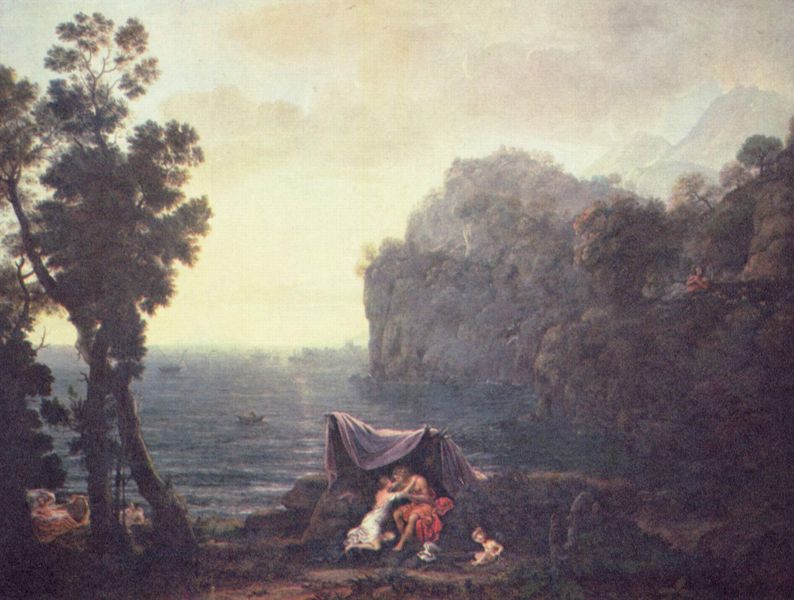
Claude Lorrain, Acis and Galatea
Dostoevsky frequently referred to this painting in his works. Find the myth
that the title refers to, and think about what this image might represent to
Dostoevsky.
Check this website for more information about Dostoevsky's allusions to this
painting: http://www.utoronto.ca/tsq/DS/03/061.shtml
Final paper: Due, by e-mail, May 26. NO LATE PAPERS ACCEPTED.
Possible topics: If you have an idea for a topic, be sure to send it to me for
approval before you begin working on it.
1. Religious vision in Dostoevsky.
2. Provincial life: How does Flaubert's protrait of provincial life compare/contrast
to life in Balzac's Paris? Be specific, and be sure to look for overlapping
influences.
3. Heroes: What kind of hero is Bazarov? How does he reflect the philosophical
movements of his times?
4. The provincial in the big city:: Eugene de Rastignac and Raskolnikov. What
similarities do these two tales share? How are they different, and what accounts
for their differences?
5. The bildungsroman: study this theme in any one of the novels we read, using
historical sources to supplement the novel.
7. Materialism and its effects on social customs as seen through any one
of the novels we have read.
8. Eyes and their gaze: in Pere Goriot, Madame Bovary, Crime and Punishment..
9. The theme of martyrdom in either Pere Goriot or Crime and Punishment
10. History in literature: choose any one of the novels, and research
some of the historical events that anchor its plot. (for example, the Restoration
period in France; the emancipation of the serfs; the philosophical theories
popular in 1860s Russia; the population shifts in 19th century Paris or St.
Petersburg)
11. Girls too good to be true: the sacrificing female figure in Dostoevsky.
12. The realist novel as a mirror of social ills: analyze one of the social
problems depicted in any one of the novels we have read (prostitution, alcoholism,
disease, beggary, indebtedness). Research the historical accuracy of the novelistic
depiction.
14. The prostitute in art and literature: images of prostitution in Dostoevsky
and 19th-century painting.
13. The novel and other arts: choose one theme in one of the novels we read
and analyze how that theme is mirrored in another art form. For example, you
could look at Courbet's paintings and discuss their relationship to Flaubert's
novel; you could analyze the romanticism of Donizetti's Lucia di Lammermoor
and the fantasies of Emma Bovary.
14. Cityscapes: Balzac's Paris and Dostoevsky's St. Petersburg in fact and fiction.
http://www.metmuseum.org/explore/Ingres/Ingres/HTML/el_ingres_cat145d.htm
http://www.metmuseum.org/explore/Ingres/Ingres/HTML/el_ingres_cat145_rel14f.htm
http://www.metmuseum.org/explore/Ingres/Ingres/HTML/el_ingres_cat152b.htm
Possible (not exlcusive) topics (more to come): You should certainly feel free
to suggest a topic of your own.
1. How does the resolution of the novel convey Flaubert's pessimism? (look at
the fate of Berthe; changes in Charles after Emma's death; Homais' official
recognition). How do these occurences reflect the social climate of Flaubert's
time?
2. Window imagery in Madame Bovary.
2. Iin her affair with Rodolphe, Emma is controlled by him; he dominates her
to the extent that "he made her into something compliant, something corrupt."
Leon is controlled by Emma; she is the dominant, conventionally more masculine
figure.
3. Discuss the notion of boredom and its central role in Madame Bovary.
4. "Deep down, all the while, she was waiting for something to happen.
. . . Other people's lives, drab though they might be, held at least the possibility
of an event. One unexpected happening often set in motion a whole chain of change:
the entire setting of one's life could be transformed. But to her nothing happened."
(Madame Bovary, 53). Does it seem, to the reader as to Emma, that nothing happens
in Madame Bovary?
5. Take any passage from Madame Bovary and do a close analysis of the
passage. In what ways do the themes, images, allusions, metaphors, similes reflect
the overall themes of the book?
6. By use of "indirect free style" Flaubert contrasts the viewpoints of two characters from time to time in the novel. Explore the contrasting viewpoints upon an episode in the book of Charles and Emma, or of Rodolphe and Emma..
7. Compare the opening and closing scenes of the novel. Are there common themes? What are they, and how are they conveyed?
8. In his letters, Flaubert described Madame Bovary as "a book about nothing". He described his prose as trying to fulfill the ambition to be "as transparent as a plane of glass". He argued that art should be "pure"- unalloyed by ethical judgment-and he wrote of his wish to ally art with science rather than with moral judgment. Elaborate on these three notions. What do they mean? Are they connected in some way? Does the novel exhibit them? Does Flaubert judge Emma?
9. Discuss the role of the blind beggar in each of his three appearances.
10. Discuss the role of the narrator in Pere Goriot and in Madame
Bovary.
11. Analyze the role of food and eating in the novel.
12. Analyze the theme of sight/blindness in the novel. Look at the frequent
description of Emma's eyes, and the role of the blind beggar.
(some topics taken from MIT Free User Ware)